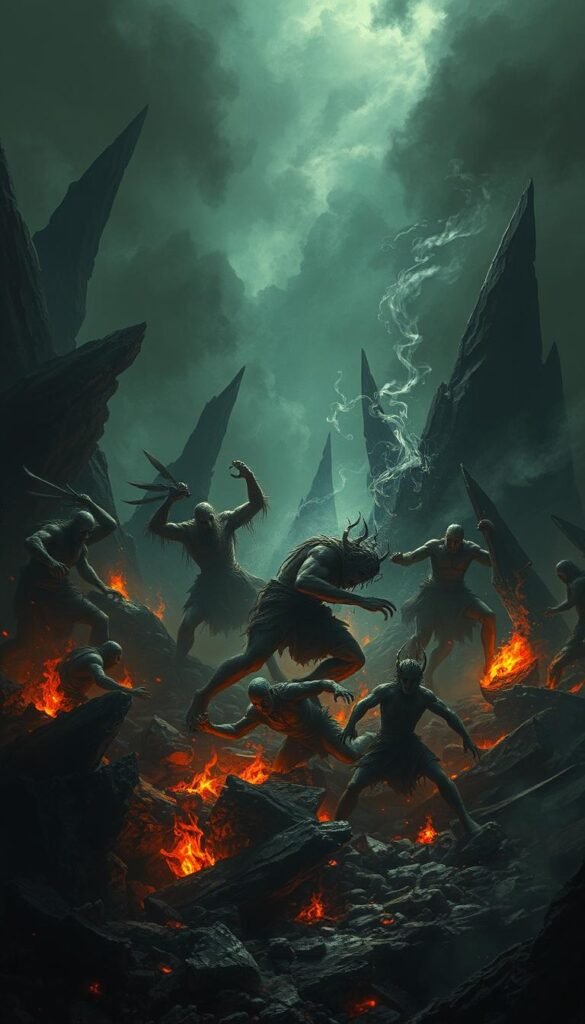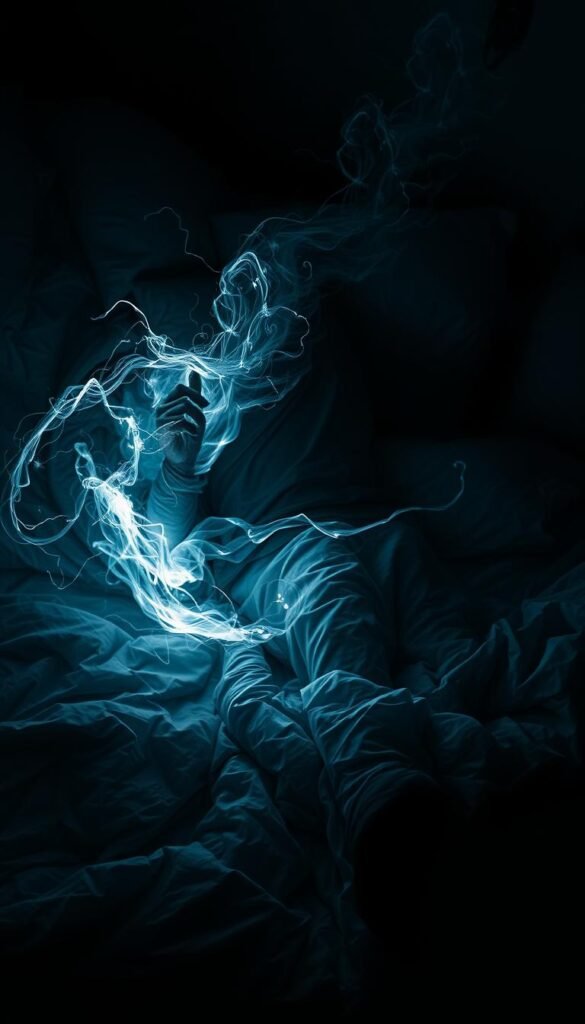Sleep is often seen as a sacred space where consciousness meets the subconscious. It’s a time for rest, yet for many, it can also bring unsettling experiences. These disturbances can feel like symbolic messages or primal energy releases, leaving us questioning their deeper meaning.
Did you know that 35-45% of adults experience unsettling dreams monthly? Meanwhile, 1-2% face more intense episodes. These occurrences are not just random; they often reflect our mental health, stress levels, or even underlying disorders.
This article blends scientific research with holistic wisdom to explore the mind-body-spirit connection in sleep health. By understanding these experiences, we can find solutions that nurture both our inner and outer worlds.
Key Takeaways
- Sleep disturbances can be both psychological and spiritual challenges.
- Unsettling dreams often reflect mental health or stress levels.
- Scientific research and holistic wisdom can work together for solutions.
- Understanding these experiences helps nurture overall well-being.
- Reflect on your sleep patterns to uncover deeper meanings.
What Are Nightmares and Night Terrors?
Dreams can be a window into our deepest fears and unresolved emotions. They often serve as a bridge between our conscious and subconscious minds, revealing what we may not confront during waking hours. While most dreams are fleeting, some leave a lasting impact, especially when they take the form of nightmares or night terrors.
Defining Nightmares
Nightmares are vivid, unsettling dreams that typically occur during REM sleep, the final third of the night. These experiences are often recalled in detail, leaving a strong emotional imprint. From a psychological perspective, they can be seen as the soul’s cinema, projecting unresolved emotions or fears. Spiritually, they may represent opportunities for shadow work, inviting us to confront hidden aspects of ourselves.
Defining Night Terrors
In contrast, night terrors occur during NREM sleep, specifically in the slow-wave phase that dominates the first third of the night. Unlike nightmares, these episodes are rarely remembered. They are characterized by intense physiological activation, such as screaming or flailing, and are often described as autonomic storms that disrupt deep restoration phases. Scientifically, they fall under the category of parasomnias, a group of sleep disorders involving abnormal behaviors or movements.
Understanding these experiences is the first step toward addressing them. Whether they manifest as vivid narratives or physiological disruptions, they offer insights into our mental and emotional well-being.
Key Differences Between Nightmares and Night Terrors

Understanding the nuances of sleep disruptions helps us address their root causes. While both experiences can be unsettling, they occur in different phases of sleep and manifest in unique ways. Let’s explore these differences to gain clarity.
Timing and Sleep Phases
One of the most significant distinctions lies in when these episodes occur. REM sleep, often associated with vivid dreams, is where unsettling dreams typically happen. These moments are like a psychic digestion, processing emotions and unresolved conflicts.
On the other hand, intense episodes occur during NREM sleep, particularly in the slow-wave phase. This stage is more about cellular renewal, making disruptions here feel like electrical storms rather than narrative experiences.
Common Symptoms and Behaviors
Unsettling dreams often leave a lasting emotional imprint. Adults may recall interpersonal conflicts, while children might describe physical threats. These experiences can lead to insomnia, as the mind struggles to process the vivid imagery.
In contrast, intense episodes are marked by physiological responses like tachycardia and sweating. These episodes, lasting 30 seconds to 5 minutes, are rarely remembered but can pose injury risks due to sudden movements.
| Aspect | Unsettling Dreams | Intense Episodes |
|---|---|---|
| Sleep Phase | REM | NREM |
| Duration | Varies | 30 sec – 5 min |
| Recall | Detailed | Rare |
| Primary Symptoms | Emotional distress | Physiological activation |
Think of unsettling dreams as haunted houses—full of vivid imagery and emotional weight. Intense episodes, however, are like electrical storms—sudden, intense, and often forgotten. Understanding these differences helps us tailor solutions to each experience.
What Causes Nightmares?

The mind’s way of processing stress and trauma often manifests in unsettling ways. These experiences, often referred to as neurological echoes, can reveal unprocessed emotions or unresolved conflicts. Understanding their causes can help us address the root issues and find peace.
Stress and Trauma
High levels of stress or traumatic events can trigger vivid, unsettling experiences. For instance, 50% of individuals with post-traumatic stress disorder (PTSD) report replicative episodes. These are not just random; they reflect the mind’s attempt to process unresolved emotions.
The stress acceleration hypothesis suggests that early trauma shapes our fear responses. This can lead to recurring patterns in our subconscious mind. Mindfulness practices, often called emotional alchemy, can help reduce these effects by calming the nervous system.
Early Childhood Experiences
Childhood experiences, even seemingly minor ones, can leave a lasting imprint. For example, a case study revealed that a childhood diaper rash trauma manifested as flood dreams later in life. These early experiences can act as seeds, growing into vivid imagery over time.
Understanding these connections allows us to address the root causes. By revisiting and processing these memories, we can reduce their impact on our subconscious mind.
Medications and Their Effects
Certain medications, such as SSRIs and beta-blockers, can increase the likelihood of unsettling experiences. These drugs alter brain chemistry, which can affect the way we process emotions during sleep.
From a spiritual perspective, these changes can be seen as shifts in our inner landscape. Being aware of these effects allows us to make informed decisions about our health and well-being.
What Causes Night Terrors?

The roots of sleep disturbances often trace back to deeper, unseen factors. These episodes, often misunderstood, can be linked to both biological and environmental influences. By exploring these causes, we can better understand how to address them.
Genetics and Family History
Our genetics play a significant role in shaping our sleep patterns. Research has identified the HLA-DQB1*05:01 genetic marker as a potential contributor to these episodes. This suggests that our ancestral sleep patterns may influence how we experience disruptions today.
Familial tendencies also matter. For example, studies show that 56% of children with a family history of sleepwalking also experience intense episodes. This highlights the importance of understanding our genetic blueprint when addressing sleep health.
Sleep Disruption and Brain Waves
Sleep disruption often stems from irregularities in brain waves. During slow-wave sleep, the brain’s activity resembles ripples in a neural ocean. When these ripples are disturbed, it can lead to intense episodes that disrupt deep restoration phases.
Conditions like sleep apnea can exacerbate these disruptions. For instance, the use of lithium or sodium oxybate has been linked to increased episodes, further emphasizing the connection between brain chemistry and sleep health.
From a spiritual perspective, these disruptions can be seen as purification crises. They invite us to confront and release stored energy, fostering harmony in our inner landscape. Energy medicine approaches, such as sound therapy or meditation, can help restore balance to our brain waves and promote restful sleep.
How Common Are Nightmares and Night Terrors?

The frequency of unsettling sleep experiences varies across different age groups. While these episodes can feel isolating, they are more widespread than many realize. Understanding their prevalence helps us see patterns and address underlying causes.
Prevalence in Children
For children, sleep disruptions are often linked to developmental stages. Around 5.3% of 13-year-olds retain intense episodes, while 1-6.5% of younger children experience them. These moments can be seen as “spiritual growing pains,” reflecting the challenges of navigating early life.
Between ages 6 and 10, vivid dreams peak, often mirroring emotional growth. In contrast, intense episodes are more common between 18 months and 5 years. This contrast highlights how different phases of childhood shape sleep patterns.
Prevalence in Adults
In adults, about 4% face recurring vivid dreams, often tied to mental health or stress. These episodes can act as “awakened psyche” indicators, revealing unresolved emotions or life challenges.
From a karmic perspective, recurring patterns may reflect lessons we need to learn. Addressing these experiences can lead to deeper self-awareness and emotional healing.
By understanding the prevalence of these episodes across ages, we can better support both children and adults in finding restful sleep.
How to Recognize Nightmares and Night Terrors
Recognizing the signs of sleep disturbances can help us better understand their origins. These experiences often leave clues, whether through vivid imagery or physical reactions. By learning to identify them, we can take steps toward healing and restful sleep.
Nightmares vs. Bad Dreams
Not all unsettling dreams are the same. While bad dreams may cause mild discomfort, vivid episodes during REM sleep often carry deeper emotional weight. These moments can feel like a mirror, reflecting unresolved fears or stress.
From a spiritual perspective, vivid dreams may act as messengers. They invite us to confront hidden aspects of ourselves. In contrast, bad dreams are often fleeting, like passing clouds in the mind’s sky.
Night Terrors vs. Sleepwalking
Intense episodes during sleep can be confusing, especially when they resemble other behaviors. For example, sleepwalkers often perform complex actions, like moving around or even eating. These moments are different from the stillness often seen during intense episodes.
Research shows that 34.4% of 18-month-olds experience these episodes. They may scream or flail, yet rarely remember the event. Broken objects in the morning can be a clue, pointing to the physical intensity of these moments.
From a spiritual lens, these episodes can be seen as energy releases. They may parallel the awakening of kundalini energy, a concept in holistic practices. Understanding these differences helps us tailor solutions to each experience.
Can Understanding My Dreams Help Me Address Nightmares and Night Terrors?
Understanding your dreams can be transformative, particularly when addressing nightmares and night terrors. By exploring the connection between dreams, individuals can gain insights into their subconscious fears and anxieties. This self-awareness often leads to more effective coping strategies and a peaceful night’s sleep, ultimately helping to diminish distressing nighttime experiences.
Effective Solutions for Nightmares and Night Terrors
Finding peace in sleep requires understanding and addressing its disruptions. Whether you’re dealing with vivid dreams or intense episodes, there are tailored approaches to help you reclaim restful nights. Let’s explore a blend of psychological, lifestyle, and medical solutions that can transform your sleep experience.
Psychological and Behavioral Therapies
One of the most effective treatment options is image rehearsal therapy. This method, particularly successful for PTSD-related episodes, involves rewriting the script of your dreams. By visualizing a positive outcome, you can reduce their emotional impact.
Another approach is cognitive behavioral therapy for insomnia (CBT-I). Blending this with meditation techniques creates a holistic path to healing. As one practitioner shared,
“It’s not just about fixing sleep; it’s about nurturing the mind.”
For children, scheduled awakening has shown remarkable results, reducing episodes by 90%. This gentle intervention helps reset the sleep cycle without causing distress.
Lifestyle Changes and Sleep Hygiene
Think of sleep hygiene as temple-building for consciousness. Simple practices like maintaining a consistent sleep schedule and creating a calming bedtime routine can make a world of difference. Avoid screens before bed and limit caffeine to prevent sleep deprivation.
Yoga nidra, a guided meditation practice, acts as a neural reset. It helps calm the nervous system and prepares the body for deep rest. Incorporating this into your evening routine can foster a sense of safety and relaxation.
Medical Treatments and Medications
In some cases, medications like clonazepam can provide relief. From a spiritual safety lens, these treatments are seen as tools to restore balance rather than suppress symptoms. Always consult a healthcare provider to explore this option.
Supplements like L-5-HTP have also shown promise in reducing episodes. Research indicates that this natural compound supports serotonin production, promoting a calmer sleep environment.
By combining these approaches, you can create a personalized plan that addresses both the mind and body. Remember, restful sleep is not just a goal—it’s a journey toward holistic well-being.
Conclusion
Every night offers a chance to reconnect with ourselves through rest. By embracing a whole-self sleep philosophy, we can transform sleep into a healing experience. With 35-45% of adults facing unsettling dreams, understanding their roots in mental health, stress, or disorders is key to finding solutions.
Take a moment to visualize a peaceful night. Imagine your body and mind in harmony, ready for deep restoration. This practice not only calms the nervous system but also fosters spiritual growth through shadow integration.
Think of each night as a shamanic journey to self-discovery. By addressing these experiences with compassion and treatment, we can turn rest into a powerful tool for transformation. Sleep is not just a pause—it’s a pathway to wholeness.
